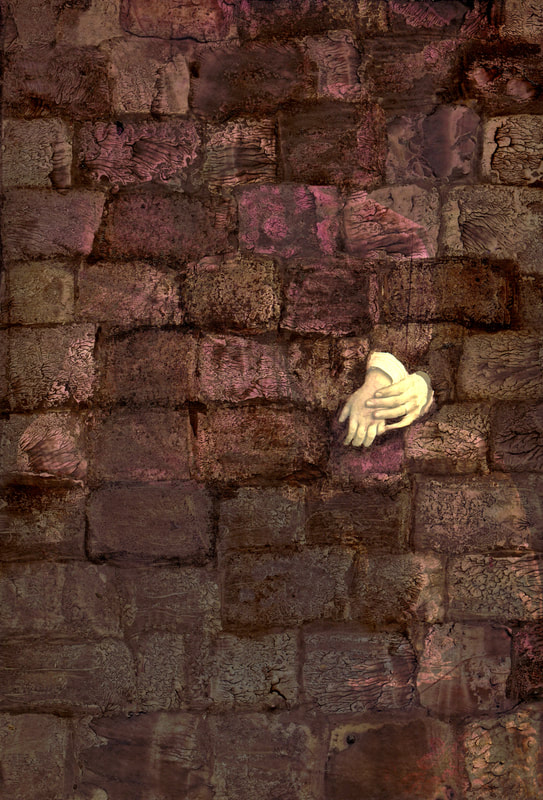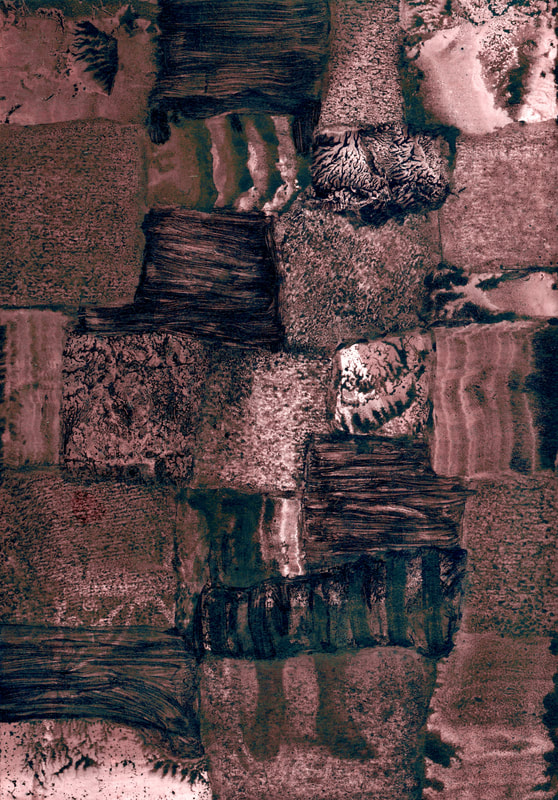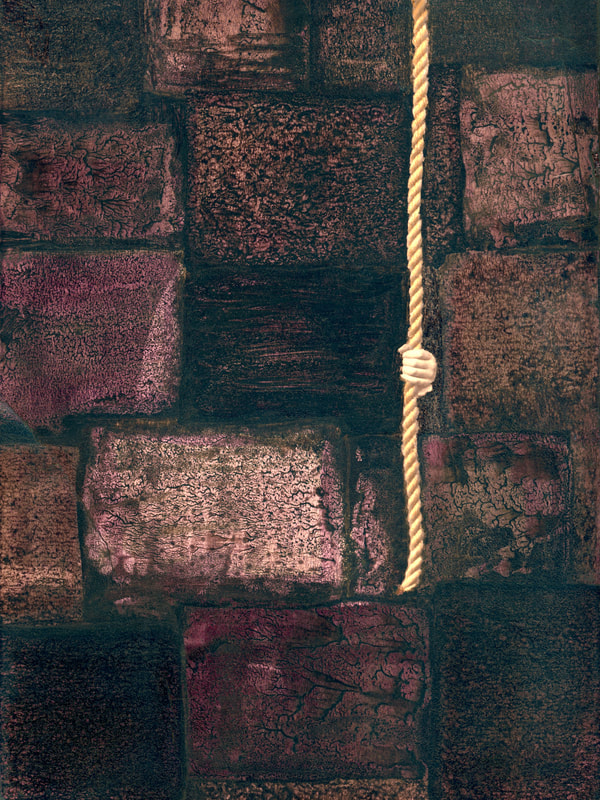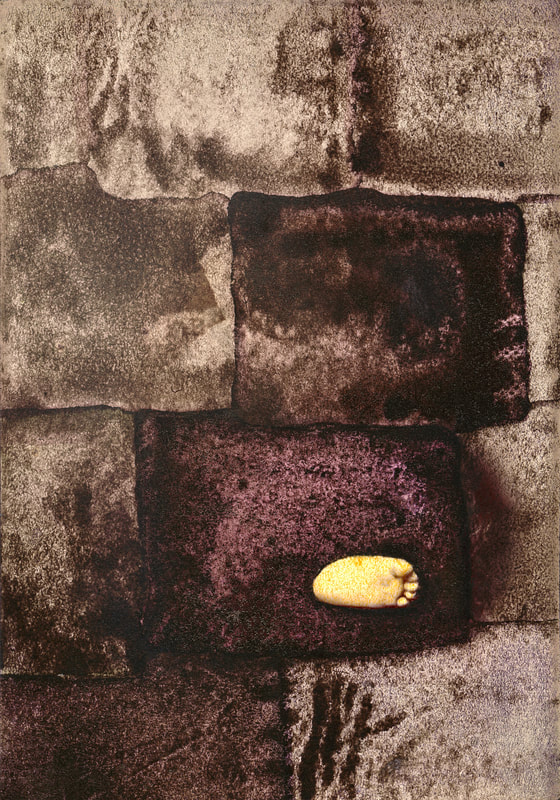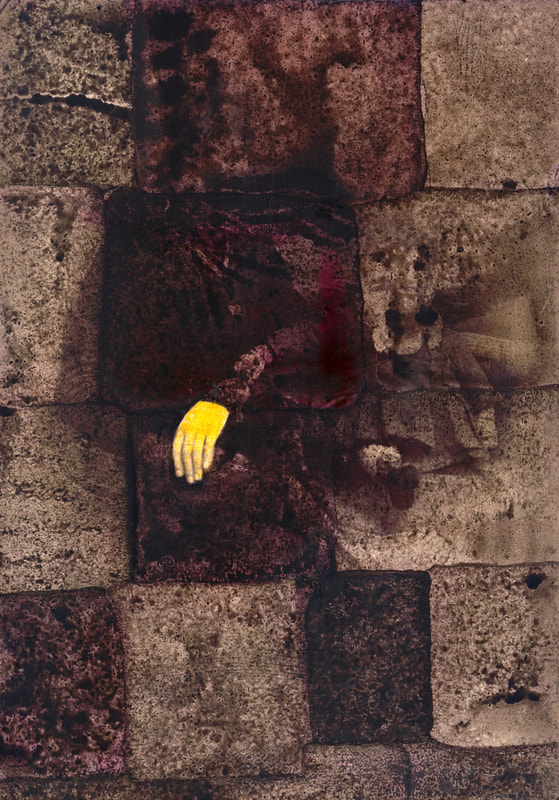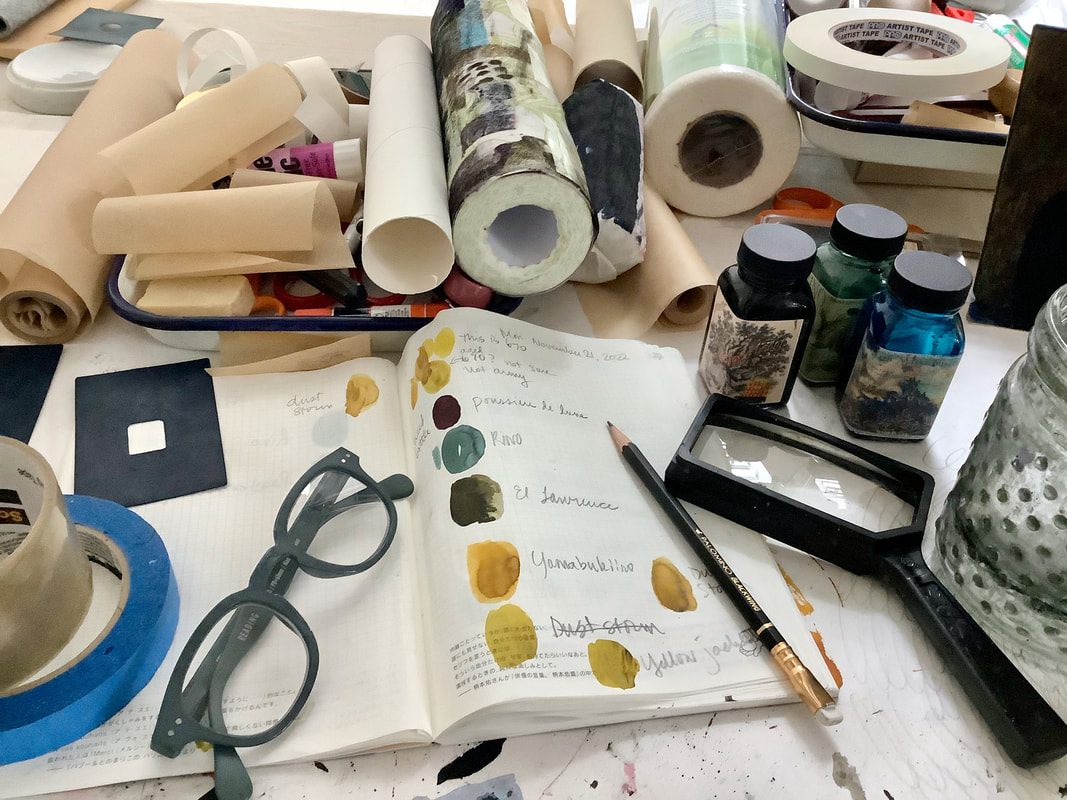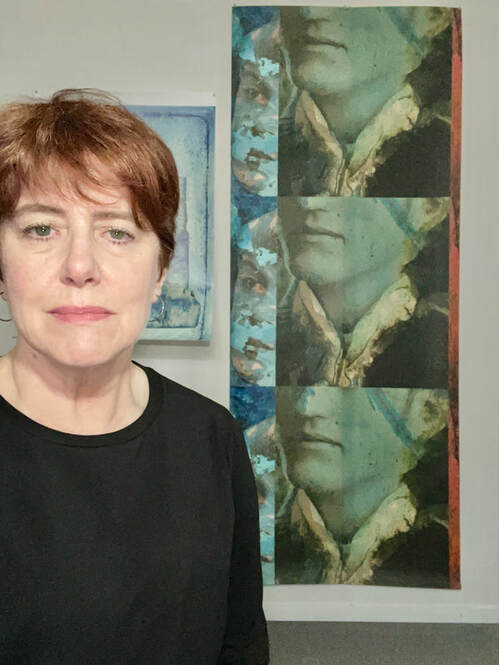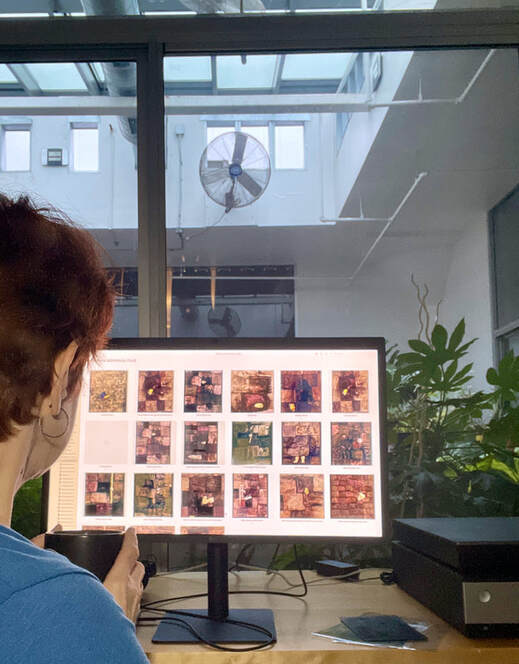Julie Blankenship works with found, vintage photos. Painting and layering their surfaces with ink and dust, they become something else altogether, revealing ghostly fragments of invented stories and sparks of humanity. Inspired by archives, her work explores history, alluding to metamorphoses, dark histories and gothic struggles.
Based in San Francisco, she received a BFA in photo and MFA in painting from SFAI, where she later taught. She co-founded SFAI Community Initiative as part of efforts to save the school. As Executive Director of Visual Aid, an arts/social justice organization serving artists with AIDS, she curated exhibitions and founded Visual Aid Gallery. She runs Visual Aid Projects & Archives.
Her work was recently included in Burning Man’s Museum of No Spectators and Corporeal Gestures at Portland State School of Architecture. Her work has been exhibited at American Institute of Architects Center for Architecture+Design Gallery, Walter/McBean Gallery, SF Camerawork and The Lab in San Francisco; Amsterdams Centrum voor Fotografie and Center for Photography International, Netherlands; Seoul Culture and Arts Center, Korea.
Publications include Cut Me Up Magazine, Photo Trouvee, Poets and Writers, London Reader, Sein und Werden, Blood Bath, Vastarien, and Egaeus Press.
Based in San Francisco, she received a BFA in photo and MFA in painting from SFAI, where she later taught. She co-founded SFAI Community Initiative as part of efforts to save the school. As Executive Director of Visual Aid, an arts/social justice organization serving artists with AIDS, she curated exhibitions and founded Visual Aid Gallery. She runs Visual Aid Projects & Archives.
Her work was recently included in Burning Man’s Museum of No Spectators and Corporeal Gestures at Portland State School of Architecture. Her work has been exhibited at American Institute of Architects Center for Architecture+Design Gallery, Walter/McBean Gallery, SF Camerawork and The Lab in San Francisco; Amsterdams Centrum voor Fotografie and Center for Photography International, Netherlands; Seoul Culture and Arts Center, Korea.
Publications include Cut Me Up Magazine, Photo Trouvee, Poets and Writers, London Reader, Sein und Werden, Blood Bath, Vastarien, and Egaeus Press.
Published on March 19th, 2023. Artist responses collected in months previous.
What are you fascinated with right now?
I’m horrified by the war in Ukraine. It’s hard to look away, while Russia systematically destroys Ukraine’s cultural heritage and reduces its cities to rubble. In my work, ghosts from other times and places break through the ruins of history, reaching out to the present. Till recently, I thought of World War II as ancient history, but I was born just twelve years after it ended. As a kid, I was obsessed by Checkpoint Charley, a terrifying border crossing between East and West Germany. Surrounded by barbed wire, it was notorious for murdering escapees. In the early 1960’s, my dad was a Special Forces pilot, who flew reconnaissance missions in the Vietnam War. At the same time, we were stationed in southern Spain, during the fascist Franco Regime. The Spanish Civil War had left its mark everywhere—men with missing limbs, widows in black, and everywhere, ruins. My friends and I played war all the time. In our favorite game, we divided into two teams: big kids vs. us, the little kids. We would stand 6 feet apart and throw rocks at each other till someone started bleeding. It was glorious.
What advice would you give your younger artist self?
Keep making art. Don’t stop. If your art is ugly, make more. Polish the ugliness like a gem. If you’re blocked, make a commitment to work for 5 minutes a day, every day. If you can’t make art on a particular day, clean your studio. Put one foot in front of the other. If you carry a judge and jury around with you (in your head), accept that they’re there. Invite them to have a seat on the couch, and then go back to your work. Don’t reject or destroy your art for at least six months after making it. Just set it aside. As the Zen koan goes “Before enlightenment; chop wood, carry water. After enlightenment; chop wood, carry water.” Keep on keeping on.
What are your tools for creative resilience these days? Do you have any methods to stay positive when life becomes difficult and perhaps when you have limited time to create?
The art community has also been challenged by the struggles of the San Francisco Art Institute. The beloved school with a historic campus championed creativity and nurtured a community of brilliant weirdos. Being part of doomed efforts to save the school was agonizing. Its closure left a gaping hole in the art world. Combined with the isolation of recent years, and conceptual/technical issues I’d been working through in my art, I began to question whether I wanted to continue as an artist.
To find out how others deal with obstacles, I invited women artists to have informal conversations. Most are friends, who I chose on the basis of their work and their openness. We talked about everything from the mundane to profound challenges including bankruptcy, illness, death of spouses, hidden identities, sex trafficking, and other traumatic family secrets. Each artist explored these issues in their art, returning to them many times over the years.
These talks culminated in Difficult Subjects, a talk about the artists and their work at Kolajfest New Orleans. Researching, making connections and having these conversations took me out of myself, becoming a meditation on community, creativity, and process itself.
What is your dreamy vision for your creative career and art practice three years from now?
My dreamy vision is to have the funds to buy sumptuous paper and inks, and make tons of huge prints. I’d have a couple of studio assistants who would do scan my art, set up my website, prep my panels, and drop off packages at the post office, not to mention bookkeeping and inventory. I’d love to have my work published in beautiful art/photo magazines, a couple of gallery shows in Europe and a museum show every year. I’d be part of a great crit group and have time for sweet collaborations. And I’d reopen the San Francisco Art Institute.
How are you being kind to yourself as you look towards realizing your vision for your art career?
Participating in collaborations, large or small, give me a lot of joy. Asking for help when needed is easier said than done, but a good practice. So is helping others. I listen to my body and mind—if I feel tired or down, I ease up on myself, try and get extra sleep, cook something special or see an art show with a friend. Being present and enjoying an interaction with someone on the street or the color of the sky helps give my mind a rest.
What are you fascinated with right now?
I’m horrified by the war in Ukraine. It’s hard to look away, while Russia systematically destroys Ukraine’s cultural heritage and reduces its cities to rubble. In my work, ghosts from other times and places break through the ruins of history, reaching out to the present. Till recently, I thought of World War II as ancient history, but I was born just twelve years after it ended. As a kid, I was obsessed by Checkpoint Charley, a terrifying border crossing between East and West Germany. Surrounded by barbed wire, it was notorious for murdering escapees. In the early 1960’s, my dad was a Special Forces pilot, who flew reconnaissance missions in the Vietnam War. At the same time, we were stationed in southern Spain, during the fascist Franco Regime. The Spanish Civil War had left its mark everywhere—men with missing limbs, widows in black, and everywhere, ruins. My friends and I played war all the time. In our favorite game, we divided into two teams: big kids vs. us, the little kids. We would stand 6 feet apart and throw rocks at each other till someone started bleeding. It was glorious.
What advice would you give your younger artist self?
Keep making art. Don’t stop. If your art is ugly, make more. Polish the ugliness like a gem. If you’re blocked, make a commitment to work for 5 minutes a day, every day. If you can’t make art on a particular day, clean your studio. Put one foot in front of the other. If you carry a judge and jury around with you (in your head), accept that they’re there. Invite them to have a seat on the couch, and then go back to your work. Don’t reject or destroy your art for at least six months after making it. Just set it aside. As the Zen koan goes “Before enlightenment; chop wood, carry water. After enlightenment; chop wood, carry water.” Keep on keeping on.
What are your tools for creative resilience these days? Do you have any methods to stay positive when life becomes difficult and perhaps when you have limited time to create?
The art community has also been challenged by the struggles of the San Francisco Art Institute. The beloved school with a historic campus championed creativity and nurtured a community of brilliant weirdos. Being part of doomed efforts to save the school was agonizing. Its closure left a gaping hole in the art world. Combined with the isolation of recent years, and conceptual/technical issues I’d been working through in my art, I began to question whether I wanted to continue as an artist.
To find out how others deal with obstacles, I invited women artists to have informal conversations. Most are friends, who I chose on the basis of their work and their openness. We talked about everything from the mundane to profound challenges including bankruptcy, illness, death of spouses, hidden identities, sex trafficking, and other traumatic family secrets. Each artist explored these issues in their art, returning to them many times over the years.
These talks culminated in Difficult Subjects, a talk about the artists and their work at Kolajfest New Orleans. Researching, making connections and having these conversations took me out of myself, becoming a meditation on community, creativity, and process itself.
What is your dreamy vision for your creative career and art practice three years from now?
My dreamy vision is to have the funds to buy sumptuous paper and inks, and make tons of huge prints. I’d have a couple of studio assistants who would do scan my art, set up my website, prep my panels, and drop off packages at the post office, not to mention bookkeeping and inventory. I’d love to have my work published in beautiful art/photo magazines, a couple of gallery shows in Europe and a museum show every year. I’d be part of a great crit group and have time for sweet collaborations. And I’d reopen the San Francisco Art Institute.
How are you being kind to yourself as you look towards realizing your vision for your art career?
Participating in collaborations, large or small, give me a lot of joy. Asking for help when needed is easier said than done, but a good practice. So is helping others. I listen to my body and mind—if I feel tired or down, I ease up on myself, try and get extra sleep, cook something special or see an art show with a friend. Being present and enjoying an interaction with someone on the street or the color of the sky helps give my mind a rest.
Find Julie Blankenship on Instagram
